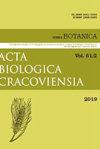Thallium hyperaccumulation in Polish populations of Biscutella laevigata (Brassicaceae)
IF 0.5
4区 生物学
Q4 PLANT SCIENCES
引用次数: 9
Abstract
Biscutella laevigata L. is known as a Tl hyperaccumulator. In Poland Biscutella laevigata occurs in the Tatra Mts (Western Carpathians) and on the calamine waste heap in Boles ł aw near Olkusz (Silesian Upland). The purpose of this work was to evaluate whether plants of both populations were able to accumulate an elevated amount of thallium in their tissues. The plants were cultivated in calamine soil in a glasshouse for a season and studied at different ages – from 2-week-old seedlings to 10-month-old adults. Additionally, the plants were grown for ten weeks in calamine soil with EDTA to enhance Tl bioavailability. The total content of Tl in plant tissues after digestion was determined by ICP-MS, whereas its distribution in leaves was studied by LA-ICP-MS. Of the total content of Tl in the soil in the range of (15.2–66.7) mg ∙ kg -1 d.m., only (1.1–2.1) mg ∙ kg -1 d.m. was present in a bioavailable form. The mean content in all the plants grown on the soil without EDTA was 98.5 mg ∙ kg -1 d.m. The largest content was found in leaves – 164.9 mg ∙ kg -1 d.m. (max. 588.2 mg ∙ kg -1 d.m.). In the case of plants grown on the soil enriched with EDTA, the mean content in plants increased to 108.9 mg ∙ kg -1 d.m., max. in leaves – 138.4 mg ∙ kg -1 d.m. (max. 1100 mg ∙ kg -1 d.m.). The translocation factor was 6.1 in the soil and 2.2 in the soil with EDTA; the biocon-centration factor amounted to 10.9 and 5.8, respectively. The plants from both populations did not contain a Tl amount clearly indicating hyperaccumulation (100–500 mg ∙ kg -1 d.m.), however, high (>1) translocation and bio-concentration factors suggest such an ability. It is a characteristic species-wide trait; B. laevigata L. is a facultative Tl hyperaccumulator. The largest Tl amount was located at the leaf base, the smallest at its top. Thallium also occurred in trichomes, which was presented for the first time; in this way plants detoxify Tl in the above-ground parts. Leaves were much more hairy in the Boles ł aw plants. This is an adaptation for growth in the extreme conditions of the zinc-lead waste heap with elevated Tl quantity.波兰laevigata(芸苔科)居群铊的超富集
laevigata L.被称为Tl超积累者。在波兰,饼干产于塔特拉山脉(喀尔巴阡山脉西部)和奥尔库什(西里西亚高地)附近博尔斯沃夫的炉甘石废料堆上。这项工作的目的是评估两个种群的植物是否能够在其组织中积累高量的铊。这些植物在温室的炉甘石土壤中种植了一个季节,并在不同的年龄进行了研究——从两周大的幼苗到10个月大的成虫。此外,植物在加EDTA的炉甘石土壤中生长10周,以提高Tl的生物利用度。用ICP-MS测定植物消化后组织中总Tl含量,用LA-ICP-MS研究其在叶片中的分布。土壤中总Tl含量在(15.2 ~ 66.7)mg∙kg -1 d.m.范围内,只有(1.1 ~ 2.1)mg∙kg -1 d.m.以生物可利用形式存在。在不含EDTA的土壤中生长的所有植物的平均含量为98.5 mg∙kg -1 d.m,其中叶片含量最高,为164.9 mg∙kg -1 d.m。588.2 mg∙kg -1 d.m)。在富含EDTA的土壤中生长的植物,其平均含量最高可达108.9 mg∙kg -1 d.m。叶片- 138.4 mg∙kg -1 d.m。1100 mg∙kg -1 d.m)。土壤的转运因子为6.1,加EDTA土壤的转运因子为2.2;生物富集系数分别为10.9和5.8。来自两个种群的植株都不含有明确表明超积累(100-500 mg∙kg -1 d.m)的Tl量,然而,高(>1)易位和生物浓度因子表明有这种能力。这是一种全物种的特征;白桦是兼性超富集植物。叶片基部Tl含量最高,顶部Tl含量最低。铊也首次出现在毛状体中;通过这种方式,植物在地上部分解毒。波尔斯沃夫植物的叶子多毛。这是一种适应生长在极端条件下的锌铅废物堆与高Tl量。
本文章由计算机程序翻译,如有差异,请以英文原文为准。
求助全文
约1分钟内获得全文
求助全文
来源期刊
CiteScore
3.00
自引率
0.00%
发文量
0
审稿时长
>12 weeks
期刊介绍:
ACTA BIOLOGICA CRACOVIENSIA Series Botanica is an English-language journal founded in 1958, devoted to plant anatomy and morphology, cytology, genetics, embryology, tissue culture, physiology, biochemistry, biosystematics, molecular phylogenetics and phylogeography, as well as phytochemistry. It is published twice a year.

 求助内容:
求助内容: 应助结果提醒方式:
应助结果提醒方式:


